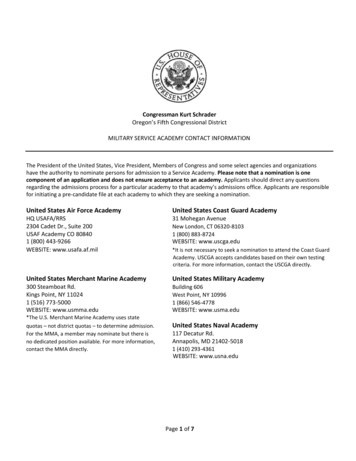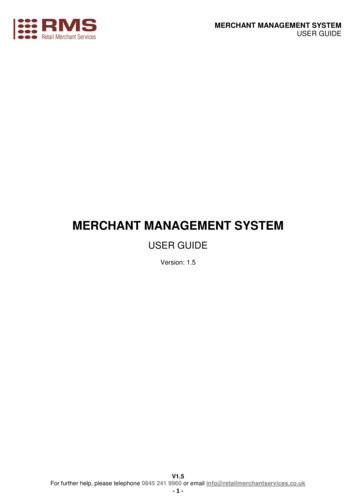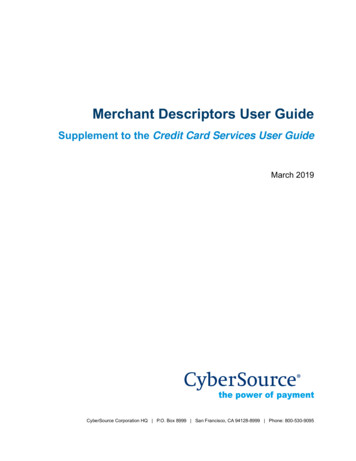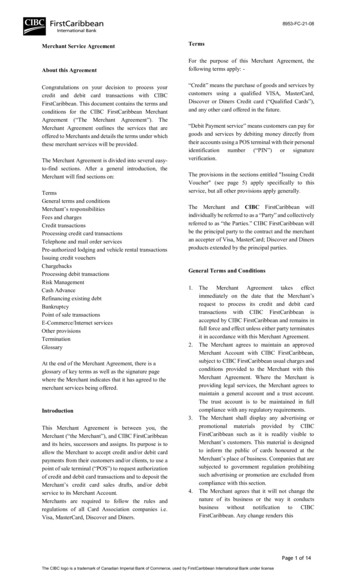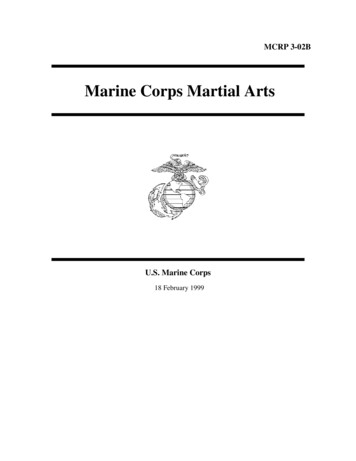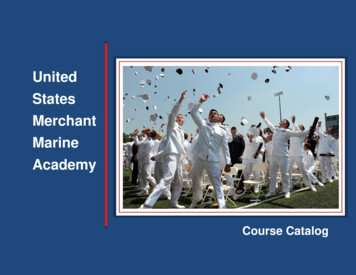
Transcription
UnitedStatesMerchantMarineAcademyCourse Catalog
UNITED STATES MERCHANT MARINE ACADEMYThe Mission of the UnitedStates Merchant MarineAcademycitizenship do apply. These requirementsare listed in this catalog.The Academy is an equal opportunityemployer.To educate and graduate leaders ofexemplary character who are inspired toserve the national security, marinetransportation and economic needs of theUnited States as licensed Merchant MarineOfficers and commissioned officers in theArmed Forces.The United States Merchant MarineAcademy is operated by the MaritimeAdministration of the U.S. Department ofTransportation.Course content and regulations at theAcademy are under constant review andrevision. Therefore, the Academy reservesthe right, whenever it deems advisable, towithdraw, cancel, reschedule or modifyany course, program of study orrequirement in connection with any of theforegoing within the limits established bylaw and Maritime Administration, U.S.Department of Transportation Orders.The United States Merchant MarineAcademy welcomes students of any race,color, creed, sex and national or ethnicorigin. Because of the specialized nature ofthe Academy’s program, and the obligationof students after graduation, requirementsregarding age, physical condition and U.S.On the cover:Commencement marks the culmination of four yearsof hard work by the members of the graduating class,who leave the U.S. Merchant Marine Academy toserve in America’s maritime industry and ArmedForces.
UNITED STATES MERCHANT MARINE atalog
UNITED STATES MERCHANT MARINE ACADEMYA Messagefrom theSuperintendentThe mission of the U.S. Merchant Marine Academy is, “to educate andgraduate leaders of exemplary character who are inspired to serve thenational security, marine transportation, and economic needs of theUnited States as licensed Merchant Marine Officers and commissionedofficers in the Armed Forces.”In peace and war, the U.S. Merchant Marine Academy has been trainingleaders for the maritime industry and the Armed Forces since 1943. Thisyear, we celebrated the 75th anniversary of the initial dedication of theAcademy at Kings Point as the fifth federal service academy.Our graduates are Master Mariners, Chief Engineers, captains ofindustry, astronauts, officers in the Army, Navy, Air Force, Marines andCoast Guard, and the backbone of the maritime industry.Young men and women who embark upon the four-year developmentalprogram here at Kings Point face significant challenges from themoment they enter the campus front gate, to the moment they toss theirhat in the air at graduation. The Four Pillars of our program - Academics,Regiment, Physical Fitness and Sea Year - combine to make a uniqueand rewarding global undergraduate experience for our students.Upon graduation, as licensed mariners, you will sail the vessels thatmove more than 90% of the goods and services to and from our country,contributing immeasurably to the health and welfare of our economy.You might also choose to serve as an active duty officer in the ArmedForces, training and leading the Nation’s finest men and women inchallenging environments around the world.This Course Catalog describes the USMMA experience in detail. Itshould answer the question, “Is Kings Point right for you?” If you arededicated and committed to leadership and selfless service, if you desirea first-class education that challenges you every single day, or if you findthe ideas of independence, self-discipline and a campus that spans theglobe attractive, it just might be.Acta non Verba!Jack BuonoRear Admiral, USMSSuperintendent
UNITED STATES MERCHANT MARINE ACADEMYA Messagefrom the AcademicDean and ProvostThe U.S. Merchant Marine Academy at Kings Point conducts aunique, intensive, engineering-centered educational curriculum thatleads to bachelor’s degrees in Marine Transportation, MaritimeLogistics and Security, Marine Engineering, Marine Engineering andShipyard Management or Marine Engineering Systems. These fivedegree programs are enhanced by general education and leadershipdevelopment courses designed to prepare graduates to serveeffectively as Merchant Marine officers and commissioned officers inthe U.S. Armed Forces immediately upon graduation. A keycomponent of the learning experience at USMMA is the sea year,during which every Midshipman serves aboard vessels at sea, allaround the globe in order to gain a firsthand perspective on themaritime industry, national security and global affairs.The Kings Point curriculum is demanding, comprehensive andstimulating. It has been carefully designed to ensure that ourgraduates are professionally competent, trained for leadership andresponsibility, and well-rounded intellectually. Therefore, KingsPointers are expected to perform well academically and alsodemonstrate skills in the regiment, on the playing field and at sea.With the strong educational and leader development experiences weprovide, our graduates are well prepared to lead with integrity,competence and high ethical standards; to think critically andcreatively to solve complex problems; to communicate proficientlyboth orally and in writing; to function effectively in the socially,economically, and culturally diverse global maritime environment andpursue life-long intellectual and professional development. We allhope you will join our team and serve our nation through an excitingand rewarding maritime career.John R. Ballard, Ph.D.Academic Dean and Provost
UNITED STATES MERCHANT MARINE ACADEMYTable of ContentsA Message From the Superintendent . 3Policy . 6Serving the Nation . 7Student Information . 11Admissions . 20Expenses and Financial Aid . 26Service Obligation After Graduation . 29The Regimental Program . 33Information Technology . 36The Curriculum . 37Academic Policies and Procedures . 72Academic Departments, Faculty, and Course Descriptions . 76Department of Engineering . 77Department of Marine Transportation . 90Department of Humanities . 106Department of Mathematics and Science . 110Department of Physical Education and Athletics . 115Department of Naval Science . 120Department of Professional Development and Career Services. 122Administration and Staff. 125Index. 132.5.
.6.UNITED STATES MERCHANT MARINE ACADEMYPolicyPolicy Regarding Discrimination and Harassment, including Sexual Harassmentand, Sexual AssaultIt is the policy of the U. S. MerchantMarine Academy to encourage thedevelopment and growth of allMidshipmen, faculty and staff in anenvironment that is free fromdiscrimination and harassment, includingsexual harassment and sexual assault.Discriminatory and harassing behaviorcreates a demeaning, intimidating, andhostile educational environment thatundermines the basic principles of theAcademy and, therefore, is not accepted ortolerated at our institution. It is theresponsibility of all Midshipmen, facultyand staff to refrain from such behavior, todiscourage it wherever found and topromptly report any such behavior, asrequired in Superintendent Instruction2016-02 (Sexual Assault, Dating Violence,Domestic Violence, Stalking, PreventionEducation and Response Policy) andSuperintendent’s Instruction 2013-02(Policy Against Discrimination andHarassment, Including Sexual Harassment,of Midshipman).The Academy is dedicated to training menand women as future officers in themerchant marine and Armed Forces whomust uphold and perpetuate the traditionsof an honorable profession. Inappropriateconduct is corrosive to the cohesiveness,morale and esprit de corps of a militaryorganization or a ship’s company.All incidents of discrimination, includingsexual harassment and sexual assault willbe investigated by the Academy or theappropriate investigative agency havingjurisdiction of the incident. All involvedwill be treated with dignity, fairness andrespect. Sexual assault victims will beprovided with victim advocacy services. Ifa violation is found, prompt and effectivecorrective action will be taken.The Academy provides training, educationand awareness to minimize discriminationand harassment.
UNITED STATES MERCHANT MARINE ACADEMYThe United States Merchant Marine Academy:Serving the NationA glimpse at a map of the United Statesshows us that we are a maritime nation. Tothe east is the Atlantic Ocean; to the west,the Pacific; off our southern border, theGulf of Mexico; in the north, the GreatLakes; and crisscrossing our states, greatrivers like the Mississippi and other inlandwaterways.Every hour of every day, ships of all typesply the waters in and around our nation.They leave our ports laden with U.S. goodsbound for foreign markets, or arrive in ourharbors with merchandise and materials forAmerican consumers.There are tankers traveling along the westcoast with raw petroleum for our refineries;Great Lakes vessels loaded with iron ore,coal or other minerals for America’sindustry; huge containerships in Easternports, their box-like containers filled withmanufactured goods; general cargo ships inthe Gulf unloading pallets of coffee andcrates of fruit; tugboats pushing andpulling barges carrying the Midwest’sgrain.These kinds of vessels, owned by U.S.companies, registered and operated underthe American flag, comprise the U.S.Merchant Marine. This fleet of highlyproductive ships is a major part of oursystem of commerce, helping guaranteeour access to foreign markets for sale ofour manufactured goods.Moreover, in time of war or nationalemergency, the U.S. merchant marinebecomes vital to national security as a“fourth arm of defense.” Our merchantships bear the brunt of delivering militarysupplies overseas to our forces and allies.The stark lessons of national conflict provethat a strong merchant marine is anessential part of American sea power.The nation’s economic and security needsmet by the U.S. merchant marine arecompelling. Today, the United Statesimports approximately 85 percent of some77 strategic commodities critical toAmerica’s industry and defense. Althoughwe, as a nation, account for only sixpercent of the world population, wepurchase nearly a third of the world’soutput of raw materials. Ninety-ninepercent of these materials are transportedby merchant vessels.A ship at sea does not operate in a vacuum.It depends on a framework of shoresideactivities for its operations. This industryincludes companies which own andmanage the vessels; ports and terminalswhere cargo is handled; yards for shiprepair; services like marine insuranceunderwriters, ship chartering firms,admiralty lawyers, engineering andresearch companies; and increasinglytoday, intermodal systems of trucks andrailroads to distribute goods around thecountry.But the most important element in aproductive merchant fleet and a strongtransportation industry is people—men andwomen who are intelligent, dedicated,well- educated and competent.7.
.8.UNITED STATES MERCHANT MARINE ACADEMYThe purpose of the U.S. Merchant MarineAcademy is to ensure that such people areavailable to the nation as shipboardofficers and as leaders in the transportationfield who will meet the challenges of thepresent and the future.The ProgramThe Academy is located in Kings Point,New York. Its 82-acre waterside campuslies on Long Island’s north shore, about 20miles east of New York City.The Academy is a national institution,operated by the Federal Government’sMaritime Administration, an agency of theU.S. Department of Transportation. TheAcademy’s four-year program centers on aregimental system that instills its students called Midshipmen (a term used for bothmen and women) - with the traits ofleadership, discipline and dedicationrequired for a career that typically mayinclude service at sea, maritimeemployment ashore, and serving as acommissioned officer in a reservecomponent of the U.S. Armed Forces.The Academy’s Regiment of Midshipmennumbers approximately 950 young menand women who represent every state ofthe Union as well as U.S. Trust Territoriesand Possessions. The size of the studentbody contributes to a true sense ofcamaraderie among the members of theRegiment and permits the Academy tomaintain an excellent student-teacher ratio.time.A sound college education is thefoundation for every profession in oursociety and the mariner’s profession is noexception. Elements of the academicprogram provide all Midshipmen with thespecialized training and education forsuccess as U.S. Coast Guard-licensedmerchant marine officers, in compliancewith the requirements set forth in theInternational Convention on the Standardsof Training, Certification andWatchkeeping for Seafarers (STCW) 1978,as well as the STCW Code in subsequentrelated amendments. The curriculum at theAcademy provides each Midshipman withthe broad college education required for aBachelor of Science degree. The militaryknowledge necessary for commissioning ina reserve component of the Armed Forcesrounds out the academic program. Fewcolleges can offer such a full range ofcredentials at graduation.During sophomore (third class) year, andagain during junior (second class) year,Midshipmen are sent to sea for practicalshipboard training. Aboard ship, sailing thetrade routes of the world, they learn thevalue of self-reliance and initiative as theygain first hand experience in the mariner’senvironment. In their senior (first class)year, they fine tune the skills learned in theclassroom and at sea as they prepare toenter the professional world.The Academy challenges its Midshipmenintellectually and physically. The academicprogram is demanding, the regimentalsystem rigorous. Freshman (fourth class orplebe) year is particularly strenuous asstudents make the transition from highschool graduate to Academy Midshipman.In their first few months, they learn manynew terms, the quality of endurance, howto perform under pressure, and mostimportantly, how to successfully manageEnrollment at the Academy requires manypersonal sacrifices, but the goal isworthwhile. Students must be prepared fornumerous demands on their time, a degreeof stress, and some limitations on theirpersonal freedom. In return, the Academydevelops leaders and prepares its graduatesfor careers that are bounded only by theirtalents and desire.
UNITED STATES MERCHANT MARINE ACADEMYAccreditationThe Academy is accredited by the MiddleStates Commission on Higher Education(MSCHE), 3624 Market Street,Philadelphia, PA 19104, (267) 284-5000,http://www.msche.org.HistoryFederal involvement in maritimetraining is more than a century old. Sincethe administration of President Ulysses S.Grant, the U.S. Government has initiatedvarious programs to train its citizens forservice in the merchant marine. TheAcademy, dedicated in 1943, representsthe realization of these efforts.Between 1874 and 1936, diverse federallegislation supported maritime trainingthrough scholarships, internships at seaand other methods. A disastrous fire in1934 aboard the passenger ship MORROCASTLE, in which 134 lives were lost,convinced the U.S. Congress that directfederal involvement in efficient andstandardized training was needed.Congress passed the landmark MerchantMarine Act in 1936, and two years later,the U.S. Merchant Marine Cadet Corpswas established. The first training wasgiven at temporary facilities until theAcademy’s permanent site in Kings Point,N.Y. was acquired in early 1942.Construction of the Academy beganimmediately, and 15 months later the taskwas virtually completed. The Academywas dedicated on September 30, 1943.President Franklin D. Roosevelt, noted atthat time that “the Academy serves theMerchant Marine as West Point serves theArmy and Annapolis the Navy.”World War II required the Academy toforego normal operation and devote all ofits resources toward meeting theemergency need for merchant marineofficers. Enrollment rose to 2,700, and theplanned course of instruction was reducedin length from four years to 18 months.Notwithstanding the war, shipboardtraining continued to be an integral part ofthe Academy curriculum, and Midshipmenserved at sea in combat zones the worldover. One hundred and forty-twoMidshipmen gave their lives in service totheir country, and many others survivedtorpedo and aerial attacks. By war’s end,the Academy had graduated 6,634 officers.World War II proved that the Academycould successfully meet the needs of anation in conflict. As the war drew to aclose, plans were made to convert theAcademy’s wartime curriculum to a fouryear, college level program to meet thepeacetime requirements of the merchantmarine. In August 1945, such a course wasinstituted.The Academy has since grown in statureand has become one of the world’sforemost institutions in the field ofmaritime education. In 1949, Congressgranted the Academy authorization forawarding the degree of Bachelor ofScience to graduates; the Academy wasfully accredited as a degree-grantinginstitution that same year. It was made apermanent institution by an Act ofCongress, signed by President Dwight D.Eisenhower, in 1956.The Academy’s national value was againrecognized as it accelerated graduatingclasses during the Korean and Vietnamconflicts, and for its involvement in suchprograms as training officers of the firstU.S. nuclear-powered merchant ship, theSAVANNAH.Admission requirements were amended in1974 and the Academy became the firstfederal service school to enroll womenstudents.During the first Persian Gulf conflict in.9.
.10.UNITED STATES MERCHANT MARINE ACADEMYearly 1991, and for many months prior tothe war, both Academy graduates andMidshipmen played key roles in themassive sealift of military supplies to theMiddle East. Midshipmen training at seahave since participated in the sealifts toSomalia, Kosovo, Afghanistan and Iraq.While the Academy’s curriculum haschanged dramatically since 1943 to reflectthe technological advances of America’smerchant marine, the institution hasmaintained its unswerving commitment toquality education and excellence among itsMidshipmen.
UNITED STATES MERCHANT MARINE ACADEMY.11.Student InformationCampusThe Academy campus and facilitiescomfortably accommodate the Regiment ofMidshipmen. The design of the buildings issimple yet functional, and the campus hasbeen laid out to take full advantage of thepicturesque waterfront of Long Island’snorth shore. The Academy’s buildings andwalkways are named after individualswhose deeds have brought fame toAmerica’s merchant marine.On the slope looking toward Long IslandSound stands a monument to theAcademy’s World War II casualties.Around this monument are grouped anoutdoor swimming pool; a boat basin andthe Yocum Waterfront Center; Gibbs Hall,with modern science and engineeringlaboratories; and Samuels Hall, which willbe renovated in 2017-2018 as a state of theart simulator center. A beautiful interfaithchapel, which serves the religious needs ofthe Regiment, stands on a grassy knoll tothe south of the War Memorial.Wiley Hall, facing Long Island Sound, isthe chief administration center of theAcademy. Formerly the home ofautomobile magnate Walter P. Chrysler,This historic building contains the officesof the Superintendent, DeputySuperintendent, Academic Dean, CivilRights Director, Public Affairs and othersenior staff. East of Wiley Hall lies thecenter of the Academy campus, marked bya striking, 176-foot flagpole. Surroundingthis landmark are Fulton Hall, the marineengineering and science building;Bowditch Hall, housing the Department ofMarine Transportation and the 900-seatAckerman Auditorium; and the SchuylerOtis Bland Memorial Library.Delano Hall, the Midshipman dining room,and six dormitory buildings - Barry, Jones,Rogers, Cleveland, Murphy, and PalmerHalls - complete the circle of buildingsenclosing the main campus. Thedormitories and dining room are connectedby an underground promenade, whichcontains the Midshipman RecreationCenter and canteen, -Navy Exchange, postoffice, laundry facilities, club spaces, seayear storage, fitness room, yoga room,bank, and barber shop.On the perimeter of the Academy areathletic fields for football, baseball,lacrosse and soccer, as well as tennis andhandball courts and a quarter-mile surfacedtrack; Furuseth Hall, containing theDepartment of Naval Science, theDepartment of Professional Developmentand Career services, the Public Safety andSecurity Office, and the AdministrativeServices Department; Vickery Gate, homeof the Admissions Office; O’Hara Hall,which has a spacious gymnasium, anindoor, Olympic size swimming pool, andathletic facilities; Patten health clinic; andLand Hall, the Midshipmen ActivitiesCenter.Although the majority of Academybuildings were constructed during WorldWar II, ongoing modernization programshave rendered the classroom, laboratoryand dormitory facilities virtually brandnew.On the northern border of the Academy liesthe McNulty Campus, named after the“father” of the Academy, Rear AdmiralRichard R. McNulty, who was instrumentalin calling public attention to the need for afederal maritime officer training school.Located in this area is the AmericanMerchant Marine Museum, a popular stopfor campus visitors.LibraryThe Schuyler Otis Bland MemorialLibrary is the Academy’s majorinformation resource center. The librarysupplies Midshipmen, faculty and staffwith a wide range of materials andservices, which can also benefit visitingresearchers. There is seating for 300users, including special conferencerooms and study areas.
.12.UNITED STATES MERCHANT MARINE ACADEMYDesigned to support the curriculum, thelibrary book collection of over 190,000volumes provides a broad range ofinformation on the subjects studied atthe Academy, with an extensiveconcentration of information andspecial collections on maritimesubjects, both modern and historical.Available at the library is a great deal ofinformation in other formats:periodicals, sea charts, magazines andnewspapers, research reports,computers, files of engineering data,compact discs, DVDs, CD-ROMs,computerized data bases, and an onlinepublic access catalog.The library has online access todatabases in many disciplines,including science, technology, thesocial sciences, and humanities. Thelibrary is part of a state-wideconsortium with 19 other New YorkState academic libraries for resourcesharing. As part of its broad role as aresource center, the library also servesas a conference site for Academyprograms. The library’s premierconference facility, the CrabtreeConference Room, provides acomfortable setting for a wide varietyof maritime and scholarly activitiesattended by Midshipmen, faculty andstaff.Midshipman Activities CenterLand Hall is the site of the Joseph B.Williams Midshipmen Activities Centerand serves as the focal point of manyextracurricular and recreational activities.The building contains club and meetingrooms, and is used for informal dinners andparties. The office of the Director ofStudent Activities is located here, as wellas the Midshipman Pub, with its regulatedhours of operation.Food ServicesThe commissary in Delano Hall providesMidshipmen with daily meals. Mondaythrough Friday, breakfast and dinner areserved buffet style, while lunch is servedfamily style. On weekends, all meals areserved buffet style. Breakfast, lunch anddinner are offered on Saturday. On Sunday,brunch and dinner are offered. In additionto regular menu selections, breakfastfeatures a fruit bar. At lunch and dinner,there is a salad bar and soup bar.The Seafarer Restaurant, open to the publicas well as to Midshipmen, is a cafeteriastyle facility. It offers a full breakfast andlunch menu, Monday through Friday. TheSeafarer is also open for evening meals,Monday through Thursday. It is closed onSaturday and reopens Sunday evening forpizza and snacks.HealthcareThe Office of Health Services (OHS) has aunique mandate to provide Midshipmenwith the medical, dental, and mental healthservices that are prerequisites forassignment to sea duty; application for aStrategic Sealift Officer, U.S. NavyReserve (SSO, USNR) commission; andapplication for a U.S. Coast Guard (USCG)license.The OHS, located in Patten Hall Building,is comprised of three health care services: aMedical Clinic, a Dental Clinic, and aMidshipman Counseling and PersonalDevelopment (MCPD) office. Allhealthcare services are located in onebuilding, which facilitates staffintercommunication and expedites manyhealth-related processes for Midshipmen.Healthcare providers available toMidshipmen include: a New York State(NYS) fully licensed and credentialedPhysician who acts as Chief MedicalOfficer (CMO); NYS Licensed Physician’sAssistants; a NYS Registered Nurse; aNYS Licensed and Credentialed Dentist; aCertified Dental Assistant; a NYSRegistered Dental Hygienist; a NYSLicensed Mental Health Counselor and aNYS Licensed Clinical Psychologist. OHSalso manages and operates the MidshipmenEmergency Medical Services Squad whichis comprised of Midshipmen who havetrained for and passed the NYS EmergencyMedical Technician (EMT) certificationrequirements. OHS follows the standardsof the Joint Commission on theAccreditation of Healthcare Organizations
UNITED STATES MERCHANT MARINE ACADEMY(JCAHO) and is compliant with the HealthInsurance Portability and Privacy Act(HIPAA) as well as the Family EducationRights & Privacy Act (FERPA).OHS services are generally available byappointment Monday – Friday, 0730 –1630. Midshipmen may report with noprior appointment required during SickCall, Monday – Friday, 0700 – 0900.Midshipmen in duty status who requireemergency care or urgent care when OHSis closed are transported via the USMMAAmbulance System by NY State CertifiedMidshipmen EMTs. For emergenciesand/or urgent care needs, Midshipmen aretransported to the Emergency Departmentat the North Shore University Hospital inManhasset, NY, located 5 miles from theUSMMA campus.Health and Insurance CoverageMidshipmen actively enrolled in academicclasses are provided basic medical, dentaland mental health care onsite at USMMAOHS. Healthcare provided onsite in supportof the USMMA academic program areprovided at no cost to Midshipmen.OHS as
UNITED STATES MERCHANT MARINE ACADEMY The Mission of the United States Merchant Marine . services like marine insurance underwriters, ship chartering firms, admiralty lawyers, engineering and research companies; and increasingly . International Convention on the Standards of Training, Certification and Watchkeeping for Seafarers (STCW) 1978
